2009 Kawasaki Jet Ski Ultra 260X Review
Big water standout reclaims horsepower crown
Sea-Doo raised the stakes in the horsepower battle last year, leapfrogging Kawasaki’s popular Ultra 250X with a claimed 255hp warrior of its own. This year, Kawasaki returns the favor, unveiling the new Ultra 260X. Let the games begin.
As you may suspect, the 260X is not the result of some radical redesign. Instead, Kawasaki wisely chose to subtly tweak the existing 250X in order to produce a not-so-subtle result — a horsepower rating that once again tops the industry. It’s all about bragging rights, after all, and at least for 2009, Kawasaki once again owns them.
Obviously, Kawasaki’s existing 250hp powerplant had the potential. At its heart is a 1498cc, dual-overhead-cam four-cylinder utilizing a Roots-type supercharger with an intercooler to combat heat and further cool the air being force-fed to the engine. Kawasaki argues that the Roots style of supercharger is superior due to its ability to produce a significant amount of boost at low rpm, commonly considered a weak point for many PWC. The system features a maximum boost of 11.4 PSI.
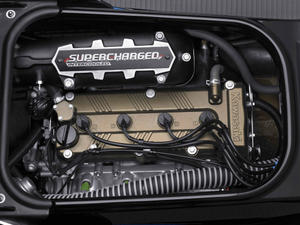 Kawasaki tweaked the 1,499cc engine to find an extra 10 ponies.
Kawasaki tweaked the 1,499cc engine to find an extra 10 ponies.Bumping that now-proven engine up 10 horses involved simple engineering. New pistons, cast with revised crowns, have played a role in raising the compression ratio from 7.8:1 to 8.4:1. New high-lift cams have also increased the intake from 7.8mm to 8.5mm and exhaust from 7.5mm to 8.2mm. A revised ignition, with four more degrees of advance, taps the potential of those changes, as does an impeller modification. Kawasaki explains that lessening the actual “twist” on the screw’s triple blades results in more linear thrust, in this case a full 61 more pounds than produced by the 250. The goal? Bragging rights are the obvious, but acceleration was most likely the practical target. Prototype testing with a light load showed the boat reaching 30 mph in as little as 1.8 seconds; top speeds occasionally flirted with the 69mph mark. Even with more realistic water and load conditions, I still expect the craft to maintain that low-end performance, and easily reach 65mph.
Aside from the performance goals, Kawasaki also appears to have dealt with a potential maintenance concern. Though never officially acknowledged by the company, numerous user reports point to gas making its way into the crankcase oil on some previous units. The 260’s new pistons feature a revised ring placement, which should produce a more effective seal. Other mods have been done to the craft’s hull. The design has been strengthened with additional fiberglass around the bow area to increase rigidity, although the additional material does add a small amount of weight.
Beyond those changes, and the obvious speed boost, the craft remains the familiar Ultra. Its hull is a byproduct of Kawasaki’s vast race experience, and features a deep-V, 22.5-degree deadrise. Given the craft’s substantial girth, it excels in rough water conditions. In fact, long-distance endurance racers, such as those who contest the popular Long Beach-to-Catalina race, have flocked to the craft. Everyday users will appreciate the heavy, solid feel in the rough stuff. Point the craft and it goes, with few, if any handling surprises to give one pause.
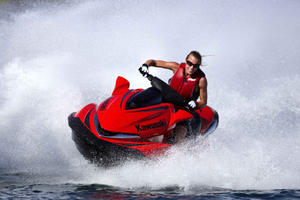 The Ultra 260X doesn’t corner as well as other high-horsepower craft.
The Ultra 260X doesn’t corner as well as other high-horsepower craft.Given that full-speed-ahead personality, riders can expect a slight trade-off in agility. In calm waters the Ultra corners nicely, but don’t expect it to carve like some of its more agile competition. This is a boat that tames the roughest conditions, and as a result it lacks the ability to turn on a dime. Turns must be muscled through to keep them tight, using an intuitive inside lean while planting the outside foot aft. Still, the craft somewhat drifts, rather hooks, through a corner.
Elsewhere, the Ultra retains its class-topping stowage and fuel capacities, although that storage spec is now down to 53 gallons from last year’s near 60 total. Fuel remains at 20.6 gallons, which gives the craft impressive range. Using the full spectrum of the craft’s horsepower, however, will likely suck that fuel down rather fast; the 250 had a reputation as a gas-hungry engine, as well as one that requires premium fuel. We don’t expect the 260 to be any better in this regard.
Ergonomic touches include a comfortable saddle that can accommodate both standing and seated positions, as well as a five-position adjustable handlebar. A series of splash-deflecting ridges promise to keep the driver relatively free of spray. Reverse is located on the left-hand side of the cowl, making for simple, intuitive maneuvering around the dock or launch ramp. A spring-loaded boarding step facilitates boarding in deep water.
Like most modern craft, a slow RPM mode is available to provide a less intimidating platform for beginning riders. Kawasaki’s Ultra 260X is activated with a second designated “key,” which also serves as a theft prevention control. My biggest gripe with the Ultra platform continues to be the information display. Certain key data, like fuel level, is poorly presented. The Mode and Set buttons are also quite small, and placed too close to the base, making it hard to manipulate with a gloved hand.
And yes, you’ll pay a little more for the ponies this year. Price has increased $300 to $11,999, still reasonable given the craft’s various competition. Kawasaki has also increased the color choices in ’09, producing three bright hues — red, lime green, and a blue/silver mix — that are in line with the Ultra’s performance attitude.
The end result? Expect the 260 to build upon the success and momentum of the 250 before it. It’s the rough water king…and at least for the immediate future, also the biggest gun in the arsenal.
| Kawasaki Jet Ski Ultra 260X Specs | |
| Length | 132.7 inches |
| Beam | 47 inches |
| Curb Weight | 1,062.8 lbs |
| Engine | Four-cylinder DOHC EFI; Supercharged/Intercooled |
| Displacement | 1,498 cc |
| Bore and Stroke | 83mm x 62.9mm |
| Compression Ratio | 8.4:1 |
| Rated Horsepower | 260 |
| Fuel Capacity | 20.6 gal. |
| Combined Stowage Capacity | 53 gal. |
| Colors | Sunbeam Red, Ebony/Galaxy Silver, Ebony/Lime Green |
| Price | $11,999 |
Related Reading
2008 Kawasaki Jet Ski Ultra 250X Review
2008 Kawasaki Jet Ski Ultra LX Review
2009 Kawasaki Jet Ski Lineup Unveiled
Get PersonalWatercraft.com in your Inbox!
Like PersonalWatercraft.com on Facebook
Comments
Most Popular

Remembering the Sea-Doo XP

2025 Yamaha JetBlaster PRO 2-Up Review

2024 Kawasaki Jet Ski STX 160X Review

2024 Yamaha GP HO Review

2017 Kawasaki Jet Ski Ultra 310LX Review




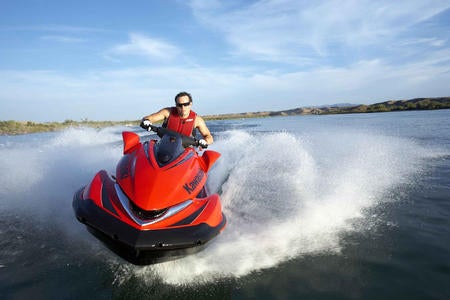
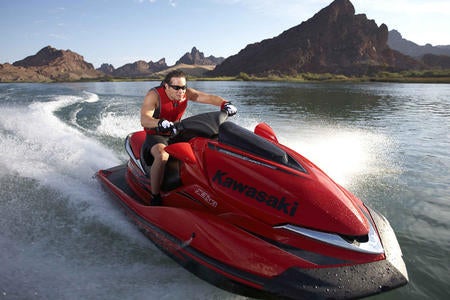
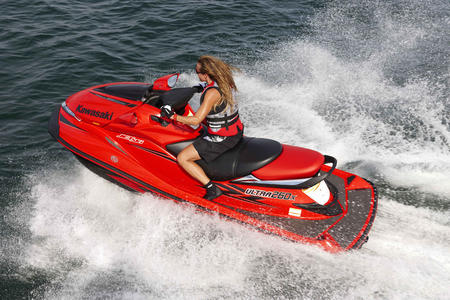







 Your Privacy Choices
Your Privacy Choices